中文词条原文链接(无法从中国内地访问):请点击这里访问
英文词条原文链接(无法从中国内地访问):请点击这里访问
本文基于英文词条的线索,并补充部分来自中文词条的内容(在二者冲突时,以更晚更新者为准)。辽观搬运时进行了必要的合规化处理,以使其能够在中国内地上传。部分文字采用汉语拼音方式代替,音节后的数字表示汉语拼音规则中的声调。
关于辽观的维基百科搬运计划,及其他已搬运的词条,请点击这里了解更多。维基百科(Wikipedia)是美国维基媒体基金会的互联网百科项目,其内容可能受到立场、信息来源等因素影响,请客观看待。正文内容不代表译者观点。
辽观提供的翻译仅供参考。文中可能包含无法从中国内地访问的链接。
辽观所搬运的词条文本与维基百科一道同样遵循CC BY-SA 4.0协议(辽观搬运的中英文对照版本),在符合协议要求的情况下您可以免费使用其内容(包括商用)。图片和视频可能遵循不同的共享协议。请点击这里访问
目录
0. 概述
辽观注:此标题是我们在搬运、整合过程中添加的。
As of December 2017, there are 229 commercial airports in China.[1]
【参考译文】截至2017年12月,中国有229个商用机场。[1]
Around 500 airports of all types and sizes were in operation in 2007, about 400 of which had paved runways and about 100 of which had runways of 3,047 m or shorter. There also were 35 heliports in 2007, an increasingly used type of facility. With the additional airports came a proliferation of airlines.
【参考译文】2007年,约有500个各类规模的机场在运营,其中约400个机场拥有铺筑跑道,约100个机场的跑道长度在3047米或以下。2007年还有35个直升机停机坪,这种设施的使用越来越广泛。随着机场数量的增加,航空公司也大量涌现。
China has the fastest growing passenger air market of any country in the world (by total passenger numbers) and between 2009 and 2014 the number of passengers increased over 47% from 266,293,020 to 390,878,784.[2] In 2014 China was second only to the United States in total numbers of passengers carried.[2]
【参考译文】中国的客运航空市场是全世界增长最快的(按乘客总数计),2009年至2014年间,乘客数量从266,293,020人次增长到390,878,784人次,增幅超过47%。[2]2014年,中国航空客运总量仅次于美国。[2]
中华人民共和国国务院办公厅在2016年发布的公文[2]表明,政府要求在2020年前建成500个以上的通用机场,实行地级市普及通用机场(或兼顾通用航空服务的运输机场)。
1. 历史 | History
1.1 解放前
辽观注:此标题是我们在搬运、整合过程中添加的。
The Nanyuan Airport first broke ground in Beijing near the end of the Qing Dynasty, and Chinese aviation pioneers Qin Guoyong and Li Ruyan,[3] the principal and chief of the flight school operations established there in 1913 under then-president Yuan Shikai, had established the first airline service with a route between Beijing and Baoding in 1914.[4][5] The Beijing Nanyuan Airport ceased civil aviation operations in 2019, after 109 years of service.[6]
【参考译文】南苑机场于清末在北京破土动工,中国航空先驱秦国镛和李如雁[3]于1913年在当时总统袁世凯的支持下,在那里创办了飞行学校并担任校长和首席飞行指挥。1914年,他们开通了北京至保定的首条航线服务。[4][5]经过109年的运营,北京南苑机场于2019年停止了民航业务。[6]
In 1922, warlord Cao Kun conducted a 3-day trial tour for “Beijing-Han Airlines” using a Handley Page aircraft (likely a HP O/400 bomber modified for passenger use). That March 31, the aircraft hit trees, crashed, and burned, on approach to Beijing-Nanyuan, killing all 14 on board. This was the first airliner crash in China.[7]
【参考译文】1922年,军阀曹锟使用一架汉德利·佩奇飞机(可能是改装成客机使用的HP O/400轰炸机)为“京汉航空线”进行了为期三天的试航。3月31日,该飞机在即将降落北京南苑机场时撞上了树木,随后坠毁并起火,机上14人全部遇难。这是中国第一起商用客机坠机事故。[7]
In 1939 at Tsing Hua University a cadre of students constructed a wind tunnel with the help of Frank Wattendorf, a graduate of Harvard, MIT and Caltech. It was assigned to Tsing Hua Aeronautical Research Institute under the direction of Y. H. Ku.[8][9]
【参考译文】1939年,在清华大学,一群学生在哈佛大学、麻省理工学院和加州理工学院毕业生弗兰克·瓦特多夫的帮助下建造了一个风洞。该风洞被划归至顾毓琇指导下的清华大学航空研究所。[8][9]
Before the Chinese Civil War, there were Republic of China joint ventures with Pan American World Airways and Lufthansa. In 1946 Civil Air Transport (Air America) was founded by General Claire L. Chennault and Whiting Willauer for the relief of RoC. As a result of the Chinese Civil War, the Chinese Communist Party took control of mainland China, and only Civil Air Transport moved along with the Kuomintang (KMT)-controlled RoC government to Taiwan.[10][page needed]
【参考译文】国共内战前,中华民国与泛美航空和汉莎航空有合资企业。1946 年,陈纳德将军和惠廷·维劳尔为救济中华民国而创立民航运输公司(Air America)。由于国共内战,中国共产党控制了中国大陆,只有民航运输公司随国民党控制的中华民国政府迁往台湾。[10][需要页面]
1.2 1949-1986
辽观注:此标题是我们在搬运、整合过程中添加的。
1949年11月2日,中国共产党决定在中央人民政府人民革命军事委员会下设民航局;12月,军委民航局成立,在天津、上海、重庆、广州设办事处[3]。
With assistance from the Soviet Union, during the 1950s China built airports in major cities or enlarged the existing airports.[11]: 376
【参考译文】在苏联的援助下,中国在 20 世纪 50 年代在主要城市修建了机场或扩建了现有机场。[11]: 376
1958年2月27日,民航局改为中华人民共和国交通部部属局,各地民航站改为民航系统与省级政府交通厅双重领导。1960年11月17日,中国民用航空局改称“中华人民共和国交通部民用航空总局”。此前,全国进入大跃进。民航领域提出“运输航空四通八达,专业航空遍地开花”的口号。各地方政府纷纷购买飞机,修建机场、开辟地方航线[4]。以江苏省交通厅为例,投资修建了淮阴民航机场[5]和南通兴仁飞机场[6],开通淮阴、南通与省会南京之间的航线,但仅经营数年就停航。
The national air carriers of communist countries were the first to obtain landing rights in China.[12] Pakistan’s national air carrier was the first of any non-communist countries’ national air carrier to do so.[12] Those landing rights were granted in August 1963 when an air travel agreement followed the Sino-Pakistan Agreement.[12]
【参考译文】共产主义国家的国家航空公司率先获得在中国的着陆权。[12] 巴基斯坦的国家航空公司是非共产主义国家中第一家获得此权的国家航空公司。[12] 这些着陆权是在 1963 年 8 月根据《中巴协议》签订的航空旅行协议中授予的。[12]
1962年4月,第二届全国人民代表大会常务委员会第53次会议决定,民航局改称“中国民用航空总局”,为中华人民共和国国务院直属局,由中国人民解放军空军代管,各省的民航局(处)均由民航局垂直领导。1969年11月20日,民航划转为中国人民解放军空军的一部分,执行军队制度;各省民航局以民航系统领导为主,同时接受大军区空军的领导,民航系统实行义务工役制,着工作服和制服,不着军装。
1980年3月,中国民用航空局脱离军队建制(除航行管制权仍由总参作战部航行局和空军司令部航行局统一领导),中国民用航空局恢复为国务院直属机构,实行企业化管理;既是政府行政部门,又以“中国民航(CAAC)”的名义直接经营航空运输[7]。
Until the 1980s, generally only senior Chinese officials, academics, or foreigners could travel by plane.[11]: 376 Few tickets were available and these had to be obtained from danwei rather than purchased at airports.[11]: 376
【参考译文】直到 20 世纪 80 年代,一般只有中国高级官员、学者或外国人才能乘飞机出行。[11]: 376 机票很少,而且必须从单位获取,而不是在机场购买。[11]: 376
1.3 1987年以来
辽观注:此标题是我们在搬运、整合过程中添加的。
1987年,中华人民共和国的民航业进行了以“航空公司与机场分设”为特征的体制改革,将原“中国民航(CAAC)”拆分成中国国际航空公司、中国东方航空公司、中国南方航空公司、中国西北航空公司、中国北方航空公司、中国西南航空公司6个公司。中国民航局不再直接承担客运职责。2002年3月,原隶属于民航局管理的航空公司以及服务保障企业正式与其脱钩,成立了六大集团公司;除首都机场、西藏自治区内机场外,其他民用机场均改由地方政府,施行属地化管理[8]。
The regulatory role was retained by the General Administration of Civil Aviation of China which is now known as Civil Aviation Administration of China.
【参考译文】中国民用航空总局(现称为中国民用航空局)保留了监管职责。
1989年,海南省航空公司登记注册成立,1993年,海南省航空公司改制成为海南航空公司,成为中国首家采纳股份制的航空企业。1997年2月,海南航空改名为海南航空股份有限公司。
2002年中国民航公司进行了重组,中国国际航空公司联合中国航空总公司、中国西南航空公司组建中国航空集团公司,中国东方航空公司兼并中国西北航空公司联合中国云南航空公司组建中国东方航空集团公司,中国南方航空公司联合中国北方航空公司、新疆航空公司组建中国南方航空集团公司。[9]
In 2004, the turnover of airfreight reached 7.18 billion ton-km, the passenger turnover was 178.2 billion person-km, and the volume of freight traffic 2.767 million tons. China had a total of 1,279 civil flight routes, 1,035 of them domestic routes reaching all large and medium-sized cities, and 244 of them international, connecting China with more than 70 cities overseas.
【参考译文】2004年,航空货运周转量达到71.8亿吨公里,旅客周转量达到1782亿人公里,货物运输量达到276.7万吨。中国共有1279条民用航线,其中1035条为国内航线,通达所有大中型城市;244条为国际航线,连接中国70多个海外城市。
目前中国航空集团公司拥有的最大上市公司为中国国际航空股份有限公司,中国南方航空集团公司拥有的最大上市公司为中国南方航空股份有限公司,中国东方航空集团公司拥有的最大上市公司为中国东方航空股份有限公司。
2022年5月19日零时,京广大通道空域结构调整方案(南段方案)启用,连接中国京津冀地区和粤港澳大湾区的南北空中交通由原先“单上单下”的双车道变为“双上双下”的四车道。[10]
China’s passenger airline industry is dominated by the three state-owned airlines; Air China, China Southern Airlines and China Eastern Airlines.[13] There are limited competition from private operators in the commercial passenger market such as Spring Airlines but the state owned operators have the political and financial wherewithal from the central government to lead the market.[13]
【参考译文】中国的客运航空业以三大国有航空公司——中国国际航空、中国南方航空和中国东方航空为主导。[13]虽然春秋航空等民营运营商在商业客运市场上存在一定的竞争,但国有运营商拥有来自中央政府的政治和财务支持,从而主导市场。[13]
China has never allowed smoking on airplanes.[11]: 376
【参考译文】中国从未允许在飞机上吸烟。[11]: 376
2. 旅客吞吐量 | Passenger throughput
In 2009, passenger throughputs of all nationwide airports reached 486.063 million, up by 19.8% over the last year; cargo and mail throughputs were 9.456 million tons, up by 7.0%.
【参考译文】2009年,全国各机场旅客吞吐量达到4.86063亿人次,比上年增长19.8%;货邮吞吐量945.6万吨,增长7.0%。
In 2009, the number of airports with passenger throughput over 1 million person-trips was 51, an increase of 4 over the last year; and the number of airports with cargo and mail throughput that is over 10 thousand ton was 45, an increase of 1 over 2008. 51 airports had over 10 thousand takeoffs and landings annually, increased by 4 as compared with the last year. All the above indicated that China’s airports had increasingly strong operation capability.
【参考译文】2009年,旅客吞吐量超过100万人次的机场有51个,比上年增加4个;货邮吞吐量超过1万吨的机场有45个,比2008年增加1个。年航班起降架次超过10万架的机场有51个,比上年增加4个。以上数据均表明,中国机场的运营能力越来越强。
The International Civil Aviation Organization reported that between 2009 and 2017, the number of air passengers carried in China increased by 140% from 229,062,099 to 551,234,509.[2]
【参考译文】据国际民航组织报告,2009年至2017年间,中国航空旅客运输量从2.29062099亿人次增加到5.51234509亿人次,增长了140%。[2]
3. 机场
主条目:中华人民共和国机场列表和中华人民共和国机场运营统计列表
Further information: List of airports in China【更多信息:中国机场列表】
2013年,中国境内民用航空(颁证)机场共有193个(不含港、澳、台地区,下同),其中年内定期航班通航机场190个,通航城市188个。

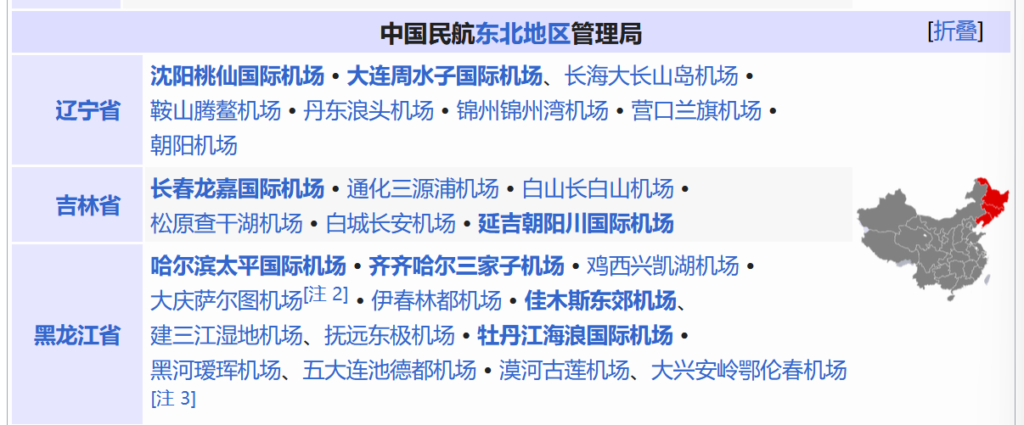
注3:大兴安岭鄂伦春机场属地权归内蒙古自治区呼伦贝尔市鄂伦春自治旗所有,但由黑龙江省大兴安岭地区管理。

注5:芜湖宣州机场位于芜湖市和宣城市宣州区境内。
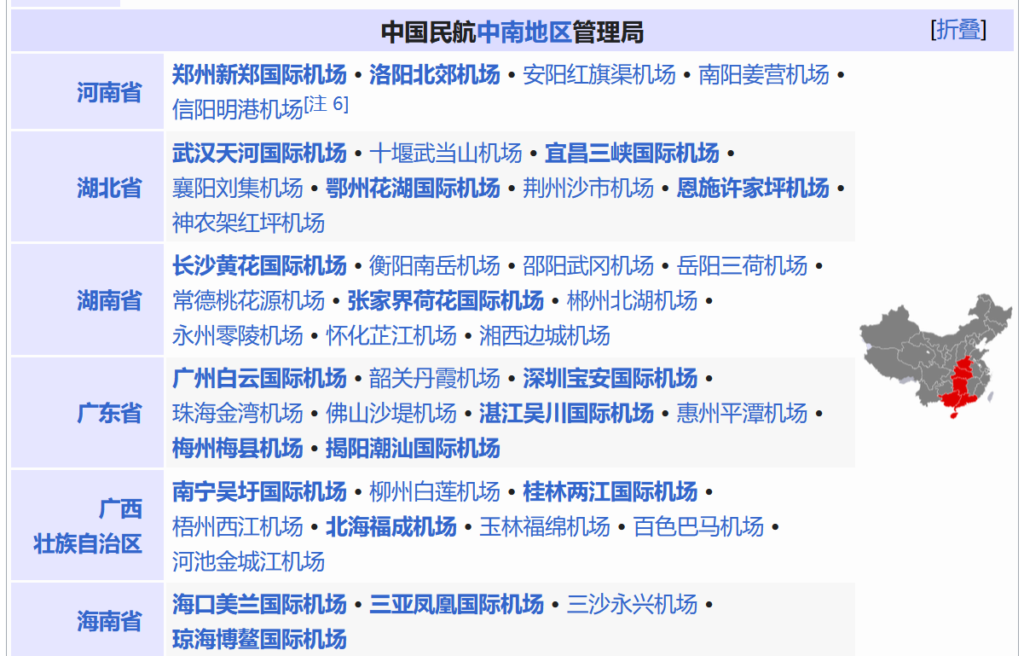
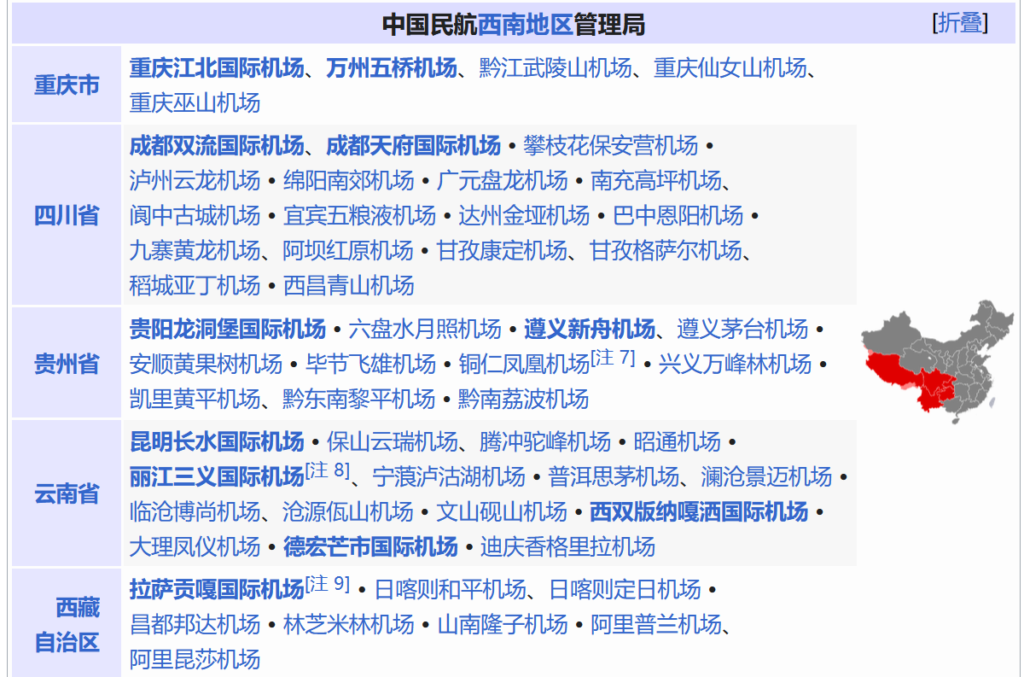
注8:丽江三义国际机场位于丽江市和大理白族自治州鹤庆县境内。
注9:拉萨贡嘎国际机场位于山南市境内,不在拉萨市境内。

注11:宁曹家堡国际机场位于海东市境内,不在西宁市境内。
注12:石河子花园机场属地权归塔城地区沙湾市所有,但由石河子市管理。
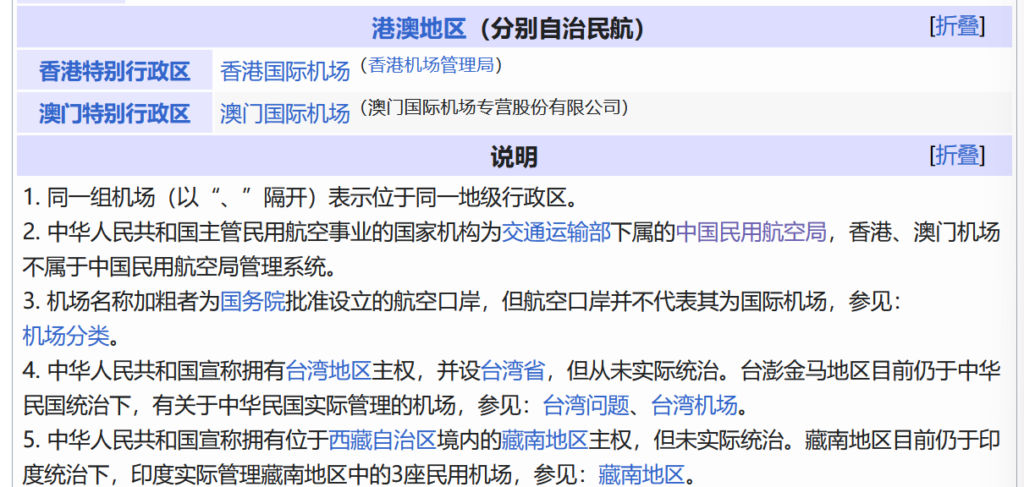
Along with passenger airport equipment, large growth has been seen in the air cargo sector. New agreements have been signed to add cargo-carrying capacity to three Chinese airlines. With that capacity will come the need for better ground facilities to handle the additional cargo. China also plans to improve aviation security systems and equipment, computer information management, settlement ticketing systems, global distribution systems and e-commerce. Airport retail concessions are also a new concept for Chinese airport authorities. As airports are faced with the challenge of making money they are considering bringing in partners via food and other retail concessions. Finally, safety equipment – including emergency vehicles – continues to be an area of interest for Chinese airport authorities. Priority will be given to foreign investment, which will be directed toward airport infrastructure construction, technology upgrade and management training.
【参考译文】除了客运机场设备外,航空货运领域也取得了大幅增长。中国已与三家航空公司签署了增加货运能力的新协议。随着货运能力的提升,将需要更好的地面设施来处理增加的货物。中国还计划改进航空安全系统和设备、计算机信息管理、结算售票系统、全球分销系统和电子商务。机场零售特许经营也是中国机场管理机构面临的一个新概念。由于机场面临着盈利的挑战,他们正在考虑通过食品和其他零售特许经营引入合作伙伴。最后,安全设备(包括应急车辆)仍是中国机场管理机构关注的领域。将优先考虑外国投资,用于机场基础设施建设、技术升级和管理培训。
China is a fast-growing market for air traffic control equipment. Over the past 10 years, CAAC has spent approximately $1 billion on air traffic management (ATM) infrastructure improvements. By 2005, China had installed 31 primary radars, 52 secondary radars, more than 1,000 Very High Frequency (VHF) communications systems, over 160 Omnidirectional Range and Distance Measurement Systems (VOR/DMEs), and more than 140 Instrument Landing Systems (ILS) (see Distance measuring equipment). CAAC Air Traffic Management Bureau’s (ATMB) goal over the next 5 years is to improve facilities in the eastern and mid-western sections of the country. The improvements call for a comprehensive data network, new automation-center systems, ground-air voice/data communications, and new en route radars.
【参考译文】中国是空中交通管制设备快速增长的市场。在过去10年里,中国民用航空局在空中交通管理(ATM)基础设施改进方面投入了约10亿美元。截至2005年,中国已安装了31部一次雷达、52部二次雷达、1000多部甚高频(VHF)通信系统、160多部全向信标测距仪(VOR/DME)和140多部仪表着陆系统(ILS)(见测距设备)。中国民用航空局空中交通管理局(ATMB)在未来5年的目标是改善中国东部和中西部地区的设施。这些改进需要建立一个综合数据网络、新的自动化中心系统、地空语音/数据通信以及新的航路雷达。
China also plans to introduce ground-to-air communications and Automatic dependent surveillance – broadcast services for international and polar routes in the west. CAAC will reorganize the current airspace structure, reducing the total number of area control centers from 27 to 5 by 2010. In reorganizing the current structure, CAAC will construct two new regional control centers, in addition to the three remaining in Beijing, Shanghai, and Guangzhou.
【参考译文】中国还计划在西部的国际航线和极地航线上引入地对空通信和自动相关监视-广播服务。中国民用航空局将重组现有的空域结构,到2010年,将区域管制中心的总数从27个减少到5个。在重组现有结构的过程中,中国民用航空局将在北京、上海和广州现有的3个区域管制中心之外,再新建2个区域管制中心。
4. 企业
4.1 航空公司
Further information: List of airlines of China【更多信息参见:中国航空公司列表】
In 2007, China predicted that over the next twenty years its air transportation passenger volume will grow annually by 11%. It will become the world’s second largest aviation market and will require an additional 1,790 aircraft to handle the increased volume. Expansion of airport infrastructure continues, with the Eleventh Five-Year Plan planning the construction of 49 new airports and 701 airport expansion projects. Furthermore, a new system of regional control centers and full conversion from program- to radar-based air traffic control will be introduced over the next 5–10 years.
【参考译文】2007年,中国预测,在未来二十年内,其航空运输旅客量将以每年11%的速度增长。中国将成为世界第二大航空市场,并将需要增购1790架飞机以满足增长的需求。机场基础设施扩建工程持续进行,“十一五”计划规划新建49座机场和701个机场扩建项目。此外,未来5至10年内,将引入新的区域管制中心系统,并实现从程序管制向雷达管制的全面转变。
The Civil Aviation Administration of China (CAAC) has been making efforts to nationalize the country’s airlines. It has completed mergers with the “Big 3” (Air China, China Eastern and China Southern) and China’s smaller, less profitable airlines. The CAAC is concentrating on expanding the number of smaller, single aisle aircraft while phasing out additional wide-body, twin aisle aircraft in the Chinese fleet. CAAC expects the new airlines to improve operating efficiencies and concentrate on developing a modern “hub-and-spoke” air routing system.
【参考译文】中国民用航空局(CAAC)一直在努力推动国内航空公司的国有化进程。它已完成与中国国际航空、中国东方航空和中国南方航空这“三大航”以及中国其他规模较小、盈利能力较弱的航空公司的合并。中国民用航空局目前正集中精力扩大小型单通道飞机的数量,同时逐步淘汰中国机队中多余的宽体双通道飞机。中国民用航空局期望新的航空公司能够提高运营效率,并专注于发展现代化的“枢纽辐射式”航线系统。
At present, CAAC is drafting the 11th Five-Year Plan and 2020 Vision for the aviation industry. It is expected that the annual growth rate will be 14%. By 2010, the total turnover will be 10 billion ton/km; the annual growth rate for general flight will be 10% and the total general flight volume will be 140,000 hours.
【参考译文】目前,中国民用航空局正在起草航空业的“十一五”规划和2020年愿景。预计年增长率为14%。到2010年,总周转量将达到100亿吨公里;通用航空的年增长率为10%,总飞行量将达到14万小时。
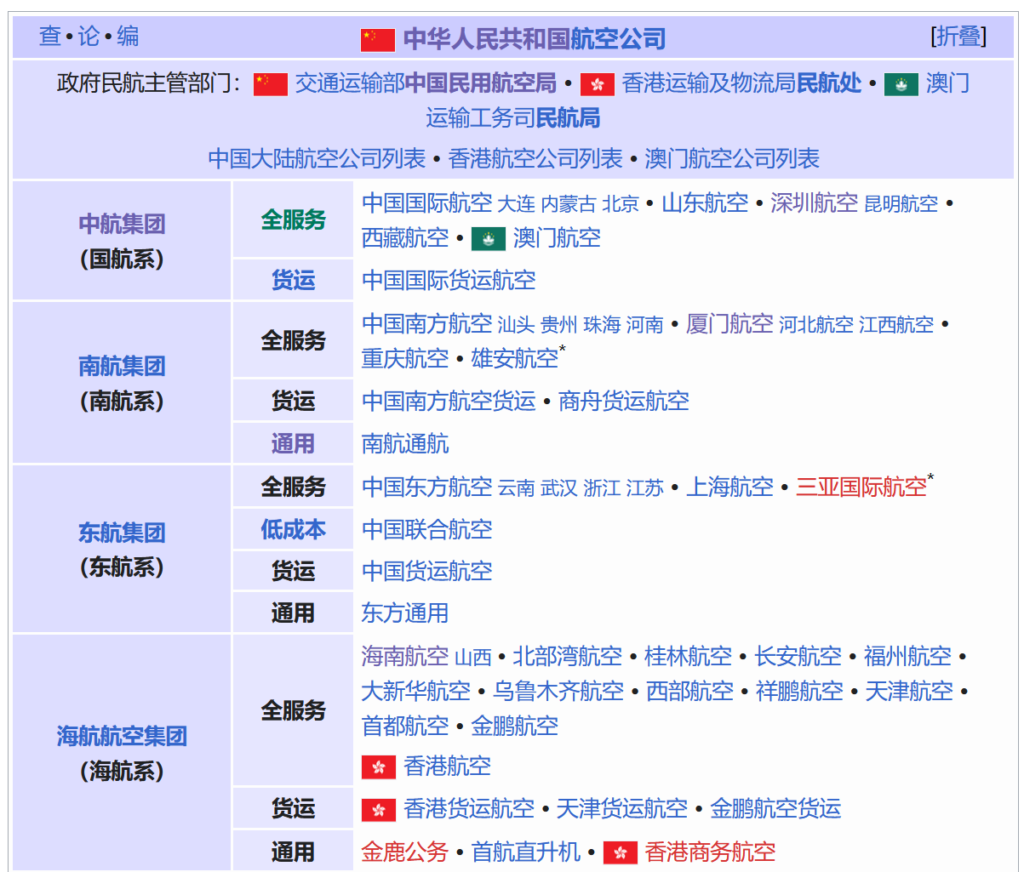


4.2 航点
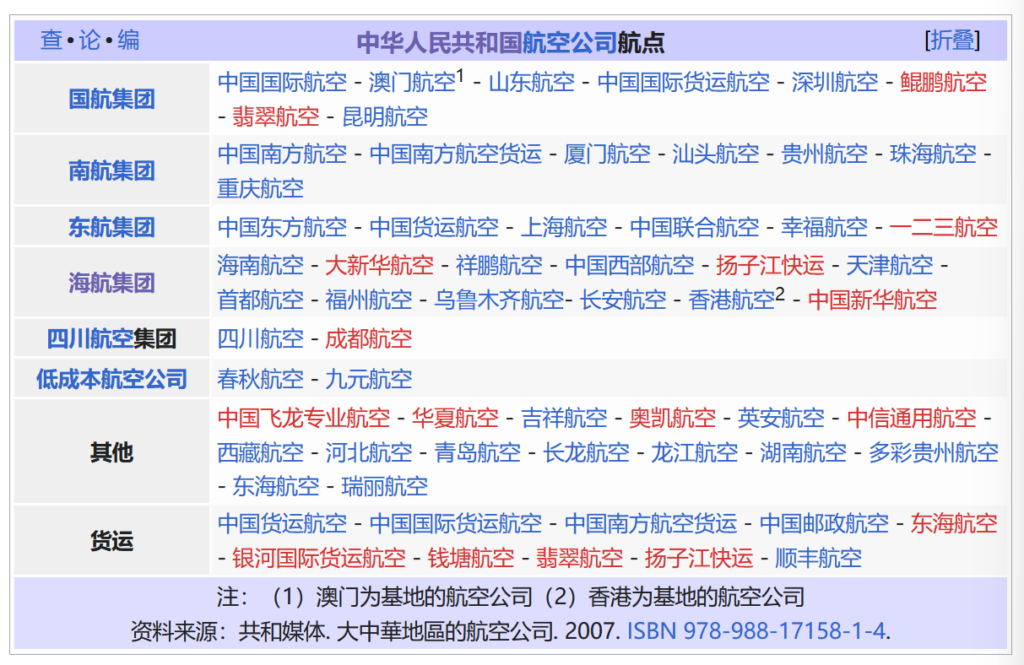
5. 产业集群 | Industrial clusters
In China, Beijing, Xi’an, Chengdu, Shanghai, Shenyang and Nanchang are major research and manufacture centers of aerospace industry. China has developed extensive capability to design, test and produce military aircraft, missiles and space vehicles. However, despite the experimental model of Y-10, which was abolished [clarification needed] in 1984, China is still developing its civil aerospace industry.
【参考译文】在中国,北京、西安、成都、上海、沈阳和南昌是航空航天工业的主要研发与制造中心。中国在军用飞机、导弹和航天器的设计、测试和生产方面已经具备了广泛的能力。然而,尽管曾试制过Y-10型号(1984年被取消[需明确情况]),中国仍在发展其民用航空航天工业。
6. 空中交通管制 | Air traffic control
China is a fast-growing ATC market. Over the past 10 years the CAAC has spent 10 billion yuan on ATM infrastructure improvements. The current (summer 2002) inventory comprises 31 radars, 52 secondary radars, more than 1,000 VHF communications systems, over 160 VOR/DMEs and more than 140 ILS units. The next target for the CAAC’s Air Traffic Management Bureau is to improve facilities in the east and mid-west of the country. A comprehensive data network, new center-automation systems, ground-air voice/data communications and new en route radars will be required over the next 10 years.
【参考译文】中国是一个快速增长的空中交通管制(ATC)市场。过去10年间,中国民用航空局在空中交通管理(ATM)基础设施改进方面投入了100亿元人民币。目前(2002年夏季),中国已配备了31部雷达、52部二次雷达、1000多部甚高频(VHF)通信系统、160多部全向信标测距仪(VOR/DME)和140多部仪表着陆系统(ILS)。中国民用航空局空中交通管理局的下一个目标是改善中国东部和中西部的设施。未来10年,将需要建立一个综合数据网络、新的中心自动化系统、地空语音/数据通信以及新的航路雷达。
China plans to introduce ground-air communications and automatic dependent surveillance services for international and polar routes in the west. The current airspace structure will be reorganized, reducing the 27 centers to five by 2010. Airspace environment in X’ian, Kunming, Chongqing and Wuhan will be improved, and over the next five years two new en route centers (in addition to Beijing, Shanghai and Guangzhou) will be built.
【参考译文】中国计划在西部的国际航线和极地航线上引入地空通信和自动相关监视服务。当前的空域结构将进行重组,到2010年,将把27个管制中心缩减至5个。将改善西安、昆明、重庆和武汉等地的空域环境,并在未来五年内(除北京、上海和广州外)新建两个航路管制中心。
Flight delays are frequent in China, with 14 out of 20 airports with the worst on-time performance being in China, Hong Kong, or Macau, according to airport statistics website FlightStats in 2015. This is because the airspace is mostly controlled by the military, and only less than 30% of China’s airspace is available for commercial airlines. This has caused many businesspeople to use the high-speed rail instead.[14]
【参考译文】根据机场数据统计网站FlightStats在2015年发布的数据,中国的航班延误情况频发,在全球准时表现最差的20个机场中,有14个位于中国、香港或澳门。这是因为中国的空域大多由军方控制,仅有不到30%的中国空域可供商业航空公司使用。这导致许多商务人士选择乘坐高铁出行。[14]
7. 制造商 | Manufacturers
- China National Aero-Technology Import & Export Corporation
- Changhe Aircraft Industries Corporation
- Chengdu Aircraft Industry Group
- ACAC consortium
- China Nanchang Aircraft Manufacturing Corporation
- Guizhou Aircraft Industry Co.
- Harbin Aircraft Manufacturing Corporation
- Hongdu Aviation Industry Corporation
- Shanghai Aviation Industrial Company
- Shaanxi Aircraft Company
- Shenyang Aircraft Corporation
- Xi’an Aircraft Industrial Corporation
- People’s Liberation Army Air Force
- China Aerospace Science and Technology Corporation
- China Aviation Industry Corporation II (AVIC II)
- Commission of Science, Technology and Industry for National Defense
- China Northern Industries
A. 中文词条参考文献
- ^ 中国民航业仍将保持高速增长势头. [2013-05-15]. (原始内容存档于2020-05-19).
- ^ 《国务院办公厅关于促进通用航空业发展的指导意见》国办发〔2016〕38号. 中华人民共和国中央人民政府网站. 2016-05-17 [2017-08-14]. (原始内容存档于2020-11-04) (简体中文).
- ^ 成立军委民航局 – 中国民航局60周年档案展. [2013-05-15]. (原始内容存档于2012-04-26).
- ^ 编纂:甘肃省地方史志编纂委员会、甘肃省志·民航志编辑委员会. 第六章节 经济核算 第一节 经济核算制度的变化. 《甘肃省志·第卷四十一·民航志》 (PDF). 甘肃人民出版社. 2003: 172 [2017-08-13]. ISBN 7-226-02795-X. (原始内容存档 (PDF)于2019-05-11) (简体中文).
- ^ 4个机场见证淮安飞天史 3、发展工业———宁淮民航线开通. 江苏省档案信息网,来源:《江苏档案》特刊2015第4期. 2015-07-04 [2017-08-14]. (原始内容存档于2017-08-13) (简体中文).
- ^ 作者:朱一卉. 细数南通的那些飞机场. 责任编辑:韩震霞、娄静. 中国江苏网. 2014-10-08 [2017-08-14]. (原始内容存档于2017-08-13) (简体中文).
- ^ 60年成就光荣梦想:回顾新中国民航业发展史(组图). [2013-05-15]. (原始内容存档于2020-10-04).
- ^ 中国民用航空局行政体制沿革. [2013-05-15]. (原始内容存档于2013-01-24).
- ^ 周音. 中新社关于三大航空集团正式确定的消息. 民航资源网(转中国新闻网). [2023-06-06]. (原始内容存档于2022-02-12) (中文(简体)).
- ^ 京广空中大通道19日零时起正式启用. [2022-05-19]. (原始内容存档于2022-05-19).
B. 英文词条参考文献 | References
- ^ “CAAC Issues the Statistics Bulletin of Civil Airports in China 2017” (Press release). Civil Aviation Administration of China. April 9, 2018. Retrieved October 26, 2018.
- ^ Jump up to:a b c “Air transport, passengers carried, 1970-2017”. The World Bank. Retrieved October 30, 2018.
- ^ 黃孝慈 (October 21, 2007). “caf02”. Archived from the original on October 21, 2007. Retrieved November 21, 2020.
民國六年七月,安徽督軍張勳擁戴清廢帝溥儀在京復辟,舉國譁然。段祺瑞馬廠誓師,南苑航校秦國鏞校長親自駕機轟炸清宮枚平叛亂。
- ^ Fang, Tianyu (September 25, 2019). “As Daxing Airport Opens, a Farewell to Nanyuan, China’s Oldest Airport”. RADII | Stories from the center of China’s youth culture. Retrieved November 17, 2020.
In 1910, Nanhaizi became home to China’s first airplane runways — also known as Nanyuan, literally “southern garden” — was soon put to use when Chinese aviator Qin Guoyong brought a Caudron trainer aircraft from France. It was the first time Chinese people ever witnessed a countryman flying an aircraft — one can imagine the excitement of visiting Nanyuan for the air show.
- ^ 中国航空工业史编修办公室 (November 1, 2013). 中国近代航空工业史(1909-1949) (in Chinese). Beijing Book Co. Inc. ISBN 978-7-5165-0261-7.
本书是一部系统完整介绍中国近代航空工业史的专著,以丰富的史实从侧面反映了一个工业门类或体系在中国艰难发展、艰苦探索的历程。
- ^ Zhuang, Pinghui (September 28, 2019). “End of an era in civil aviation as China’s first airport closes”. South China Morning Post. Retrieved November 17, 2020.
Built in 1910 during the Qing dynasty (1644-1911), China’s first airport ceased to be a civil aviation facility at 11.21pm that day when China United Airlines – the airport’s main carrier – transferred the last of its Nanyuan-based flights to Daxing.
- ^ “ASN Aircraft accident Handley Page O/7 registration unknown Beijing-Nanyuan Airport”. aviation-safety.net. Retrieved March 4, 2023.
- ^ Frank Wattendorf (September 1939) “China’s Large Wind Tunnel”, Aircraft Engineering and Aerospace Technology 11(9): 315–50, doi:10.1108/eb030539
- ^ Theodore von Kármán (1967) The Wind and Beyond, pp 192–201, Little, Brown and Company
- ^ William M. Leary (1984) Perilous Missions, Civil Air Transport and CIA Covert Operations in Asia, The University of Alabama Press, Alabama
- ^ Jump up to:a b c d Harrell, Stevan (2023). An Ecological History of Modern China. Seattle: University of Washington Press. ISBN 9780295751719.
- ^ Jump up to:a b c Hussain, Syed Rifaat (2016). “Sino-Pakistan Ties”. The new great game : China and South and Central Asia in the era of reform. Thomas Fingar. Stanford, California: Stanford University Press. p. 120. ISBN 978-0-8047-9764-1. OCLC 939553543.
- ^ Jump up to:a b Wines, Michael (August 29, 2010). “China Fortifies State Businesses to Fuel Growth”. The New York Times. New York. Retrieved October 30, 2018.
- ^ Bergman, Justin (April 29, 2016). “This is why China’s airports are a nightmare”. BBC Worklife. Retrieved January 25, 2022.
C. 外部链接
- (简体中文)中国航空集团公司(页面存档备份,存于互联网档案馆)
- (简体中文)中国国际航空股份有限公司(页面存档备份,存于互联网档案馆)
- (简体中文)中国南方航空集团公司
- (简体中文)中国南方航空股份有限公司(页面存档备份,存于互联网档案馆)
- (简体中文)中国东方航空集团公司(页面存档备份,存于互联网档案馆)
- (简体中文)中国东方航空股份有限公司(页面存档备份,存于互联网档案馆)
- (简体中文)海南航空股份有限公司(页面存档备份,存于互联网档案馆)
D. 参见(维基百科的相关词条)
————————————————————————
- 中国大陆航空公司列表
- 中华人民共和国机场运营统计列表
- 中华人民共和国机场列表
- 中华人民共和国交通运输部、中国民用航空局
- 国务院中央军委空中交通管制委员会、中国人民解放军总参谋部作战部空管局
- 中国人民解放军空军 / People’s Liberation Army Air Force (PLAAF) 、海军航空兵、陆军航空兵
- Air route authority between the U.S. and China【中美间航权】
- Lunar New Year cross-strait charter【春节两岸包机】
- China International Aviation & Aerospace Exhibition【中国国际航空航天展(珠海航展)】
- List of Chinese aircraft【中国航空器列表】
- List of Chinese aircraft engines【中国航空发动机列表】
- Aircraft acquired by Chinese for civil/private and military/warlord use from before 1937【1937年之前中国购入的民用/私营和军用航空器列表】
- List of airline holding companies【持股航空公司的公司列表】

分享到: